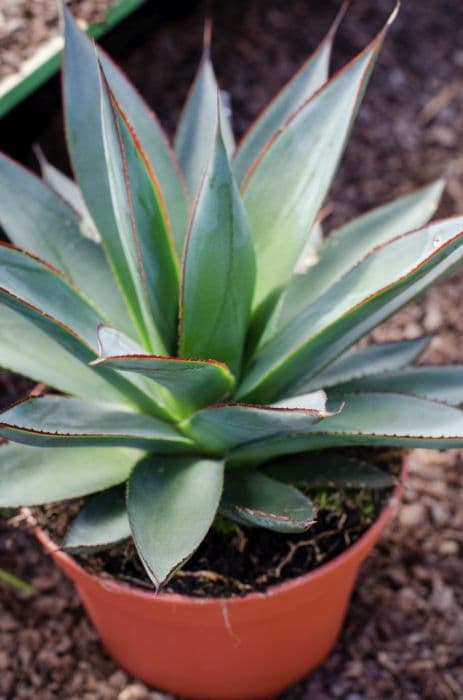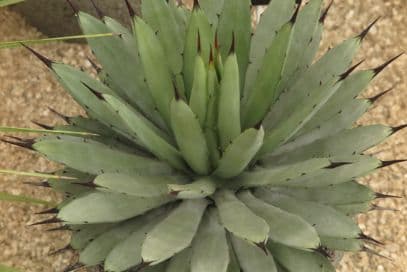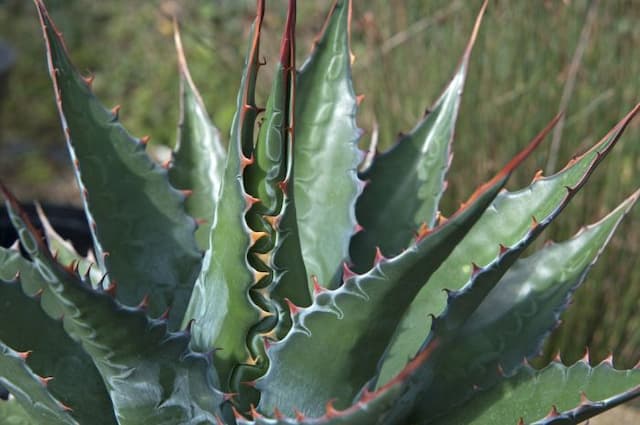Solomon's Seal Polygonatum × hybridum 'Betberg'

ABOUT
The plant known as Solomon's seal 'Betberg' has a classic beauty characterized by its arching stems from which hang pairs of leaves and delicate, small, bell-shaped flowers. The leaves are lush, oval to lance-shaped, and present a vibrant green color, sometimes with a hint of blue-green, creating a cool and calming foliage display that adds texture and interest to gardens. During the blooming period, the eye-catching flowers dangle from the leaf axils underneath the arching stems. They are typically white with green-tipped accents, lending an elegant and understated charm to the plant's overall appearance. The flowers often attract pollinators, enhancing the plant's liveliness in a garden setting. After flowering, small, round berries may appear, adding an additional layer of visual interest. These berries start out green and may turn a dark, almost black hue upon maturation. These fruiting bodies can provide food for wildlife and contrast strikingly against the foliage. Overall, Solomon's seal 'Betberg' is valued for its graceful habit and the subtle beauty it contributes to shaded garden areas or woodland settings. It has a refined and structured appearance, often being used to create serene and naturalistic compositions in garden designs.
About this plant
 Names
NamesFamily
Asparagaceae.
Synonyms
Hybrid Solomon's Seal, Striped Solomon's Seal, Variegated Solomon's Seal.
Common names
Polygonatum × hybridum 'Betberg'.
 Characteristics
CharacteristicsLife cycle
Perennials
Foliage type
Deciduous
Color of leaves
Green
Flower color
White
Height
1-2 feet (30-60 cm)
Spread
1-2 feet (30-60 cm)
Plant type
Herb
Hardiness zones
3-8
Native area
Europe
Benefits
 General Benefits
General Benefits- Ornamental Value: Polygonatum × hybridum 'Betberg', commonly known as Solomon's seal, has attractive arching stems and hanging, tubular flowers, making it a popular choice for aesthetic purposes in gardens and landscapes.
- Shade Tolerance: It thrives in part to full shade, making it ideal for woodland gardens or shaded borders where many plants may struggle to grow.
- Drought Resistance: Once established, Solomon's seal is relatively drought-tolerant, requiring minimal watering in temperate climates.
- Low Maintenance: It requires little maintenance beyond the occasional watering and mulching, making it a suitable choice for gardeners of all levels.
- Seasonal Interest: In the spring, it produces delicate, white flowers, and in the fall its foliage turns a striking yellow, providing seasonal interest throughout the year.
- Ground Cover: Its ability to spread and form colonies makes it an excellent ground cover, which can help prevent soil erosion in shaded areas.
- Wildlife Attraction: The flowers provide nectar for pollinators such as bees, and the berries can attract birds, promoting biodiversity in the garden.
 Medical Properties
Medical Properties- This plant is not used for medical purposes.
 Air-purifying Qualities
Air-purifying QualitiesThis plant is not specifically known for air purifying qualities.
 Other Uses
Other Uses- Polygonatum × hybridum 'Betberg', commonly known as Solomon's Seal, can be used as a natural dye source. The roots can be processed to produce a reddish or brown dye for textiles.
- The plant's strong stems can be utilized in basketry or as natural ties in the garden, providing a sustainable alternative to synthetic materials.
- When dried, the stems and leaves of Solomon's Seal can create rustic decorative elements for wreaths or dried flower arrangements.
- The seeds of Solomon's Seal can be used as food for wildlife, such as birds, thus contributing to biodiversity in a garden setting.
- Solomon's Seal can act as a ground cover to prevent soil erosion, thanks to its rhizomatous growth that helps stabilize the ground.
- The foliage can provide a contrasting texture in floral design, adding depth and interest to bouquets and flower compositions.
- Culinary chefs may use the young shoots of Solomon's Seal as an exotic garnish, giving a unique flavor and appearance to gourmet dishes.
- Photographers and artists may find inspiration in the plant's arching stems and dangling flowers for works of art or photographic subjects.
- Its resilience and adaptability make Solomon's Seal suitable for use in educational projects and demonstrations related to plant biology and ecology.
- The plant can be incorporated into a sensory garden, where its varied textures and gentle motion when breezy provide a tactile experience.
Interesting Facts
 Feng Shui
Feng ShuiThe plant Solomon's Seal is not used in Feng Shui practice.
 Zodiac Sign Compitability
Zodiac Sign CompitabilityThe plant Solomon's Seal is not used in astrology practice.
 Plant Symbolism
Plant Symbolism- Healing: This plant, commonly known as Solomon's Seal, is thought to symbolize healing due to its traditional use in herbal medicine to treat various ailments.
- Wisdom: The name Solomon's Seal is believed to be linked to King Solomon of biblical fame, who was known for his wisdom. The plant thus can symbolize the pursuit of knowledge and wisdom.
- Protection: In folklore, Solomon's Seal was used as a protective amulet to ward off evil spirits, giving it the symbolic meaning of offering protection.
- Good Fortune: Carrying the namesake of Solomon, who was not only wise but also wealthy, the plant is sometimes associated with bringing good luck and prosperity.
 Water
WaterSolomon's Seal requires consistent moisture, especially during its growing season in spring and early summer. Water the plant deeply once a week, providing about 1-2 gallons per plant, depending on the size and the weather conditions. Ensure the soil is well-draining to prevent waterlogging. During hot, dry spells, it may be necessary to water twice a week, while in cooler, wetter conditions, reduce watering accordingly. Always check the top inch of soil for dryness before watering.
 Light
LightSolomon's Seal thrives in dappled sunlight or partial shade. It should be positioned in a spot where it can be protected from the harsh afternoon sun, which can scorch its leaves. The ideal location is under the canopy of deciduous trees or on the north or east side of a building, where it will receive bright, indirect light.
 Temperature
TemperatureSolomon's Seal prefers moderate temperature conditions and is hardy in a range generally between 60 to 70 degrees Fahrenheit. It can survive minimum temperatures down to about 0 degrees Fahrenheit in winter. The plant is quite resilient to cold and can get through winter with mulch to insulate the root zone if conditions get colder.
 Pruning
PruningSolomon's Seal does not typically require extensive pruning. However, removing spent flower stems once blooming has finished can tidy the plant and encourage next year's growth. The best time for pruning is in late fall or early winter after the foliage has died back. Pruning in this period helps to prevent any potential disease from overwintering on dead plant material.
 Cleaning
CleaningAs needed
 Soil
SoilSolomon's Seal prefers a fertile, well-draining soil mix rich in organic matter. A good soil mixture for Polygonatum × hybridum 'Betberg' would be equal parts garden loam, compost, and leaf mold or peat moss. Aim for a soil pH of about 5.5 to 7 for optimal growth.
 Repotting
RepottingSolomon's Seal does not need frequent repotting and can typically be repotted every 3 to 5 years. Polygonatum × hybridum 'Betberg' should be repotted when it becomes root-bound or when the soil quality deteriorates.
 Humidity & Misting
Humidity & MistingSolomon's Seal thrives best in moderate to high humidity levels, though it can adapt to average room humidity. Aim for a relative humidity around 40-60% for ideal growing conditions for Polygonatum × hybridum 'Betberg'.
 Suitable locations
Suitable locationsIndoor
Place in well-lit area, avoid direct sun, water regularly.
Outdoor
Part shade, moist soil, protect from afternoon sun.
Hardiness zone
3-8 USDA
 Life cycle
Life cyclePolygonatum × hybridum 'Betberg', commonly known as Solomon's Seal, begins its life cycle when seeds germinate in moist soil, typically in spring, emerging as small shoots. As temperatures warm, these shoots develop into arching stems with alternate leaves, and the plant undergoes vegetative growth. By late spring to early summer, small, bell-shaped, white flowers with green tips appear, hanging in pairs or clusters underneath the leaves. After pollination, typically by bees, these flowers develop into small, berry-like fruits that can be blue or black when ripe, providing food for wildlife and facilitating seed dispersal. In autumn, the plant's foliage turns yellow and begins to die back, with the plant entering a period of dormancy over winter. Solomon's Seal resumes growth from its rhizomes each spring, repeating the cycle, and can also spread vegetatively by these rhizomes forming colonies over time.
 Propogation
PropogationPropogation time
Spring to early summer
The most popular method for propagating Solomon's Seal (Polygonatum × hybridum 'Betberg') is by division of its rhizomes. This is typically done in the fall after the foliage has died back or in early spring before new growth begins. To propagate by division, carefully dig around the plant to lift the rhizome from the soil. Using a sharp knife, cut the rhizome into sections ensuring each section has at least one growth bud. Replant the divisions immediately at the same soil depth from which they were taken, about an inch (2.54 centimeters) below the soil surface, and water them thoroughly. Spacing the divisions about a foot (30.48 centimeters) apart will give them room to grow. This simple method of vegetative propagation helps to maintain the specific characteristics of the 'Betberg' cultivar.









